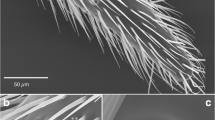Abstract
Electrophysiological responses of adult seven-spot ladybirds, Coccinella septempunctata, to (E)-β-farnesene, an aphid alarm pheromone, and (−)-β-caryophyllene, a plant-derived alarm pheromone inhibitor, were investigated by recording from single olfactory cells (neurons) on the antenna. Cells having high specificity for each of the two compounds were identified. Furthermore, these two cell types were frequently found in close proximity, with a larger amplitude consistently recorded for the cell responding specifically to (E)-β-farnesene. Preliminary behavioral studies in a two-way olfactometer showed that walking adults were significantly attracted to (E)-β-farnesene; this activity was inhibited with increasing proportions of (−)-β-caryophyllene. The possible ecological significance of colocation or pairing of olfactory cells for semiochemicals with different behavioral roles is discussed.
Similar content being viewed by others
REFERENCES
Al Abassi, S., Birkett, M. A., Pettersson, J., Pickett, J. A., and Woodcock, C. M. 1998. Ladybird beetle odour identified and attraction between adults explained. Cell. Mol. Life Sci. 54:876–879.
Blight, M. M., Pickett, J. A., Wadhams, L. J., and Woodcock, C. M. 1995. Antennal perception of oilseed rape, Brassica napus (Brassicaceae), volatiles by the cabbage seed weevil, Ceutorynchus assimilis (Coleoptera: Curculionidae). J. Chem. Ecol. 21:1649–1664.
Boeckh, J. 1962. Elektrophysiologische Unterschungen an einzelnen Geruchs-Rezeptoren auf den Antennen des Totengraber (Necrophorus: Coleoptera). Z. Vergl. Physiol. 46:212–248.
Bottrell, D. G., and Barbosa, P. 1998. Manipulating natural enemies by plant variety selection and modification: A realistic strategy? Annu. Rev. Entomol. 43:347–367.
Campbell, C. A. M., Pettersson, J., Pickett, J. A., Wadhams, L. J., and Woodcock, C. M. 1993. Spring migration of damson-hop aphid, Phorodon humuli (Homoptera: Aphididae), and summer host plant-derived semiochemicals released on feeding. J. Chem. Ecol. 19:1569–1576.
Carter, M. C., and Dixon, A. F. G. 1984. Honeydew: An arrestant stimulus for coccinellids. Ecol. Entomol. 9:383–387.
Dawson, G. W., Griffiths, D. C., Pickett, J. A., Smith, M. C., and Woodcock, C. M. 1984. Natural inhibition of aphid alarm pheromone. Entomol. Exp. Appl. 36:197–199.
Dicke, M., Sabelis, M. W., Takabayashi, J., Bruin, J., and Posthumus, M. A. 1990. Plant strategies of manipulating predator-prey interactions through allelochemicals: prospects for application in pest control. J. Chem. Ecol. 16:3091–3118.
Hardie, J., Pickett, J. A., Pow, E. M., and Smiley, D. W. M. 1999. Aphids, pp. 227–249, in J. Hardie and A. K. Minks (eds.). Pheromones of Non-Lepidopteran Insects Associated with Agricultural Plants. CAB International, Wallingford, UK.
Kang, S. K., Chung, G. Y., and Lee, D. H. 1987. A convenient synthesis of (E)-β-farnesene. Bull. Korean. Chem. Soc. 8:351–353.
Nakatuma, K. 1991. Aphid alarm pheromone component, (E)-β-farnesene, and local search by a predatory lady beetle, Coccinella septempunctata bruckii Mulsant (Coleoptera: Coccinellidae). Appl. Entomol. Zool. 26:1–7.
Nakatuma, K., and Saito, T. 1985. Recognition of aphid prey by the lady beetle, Coccinella septempunctata bruckii Mulsant (Coleoptera: Coccinellidae). Appl. Entomol. Zool. 20:479–483.
Nault, L. R., Edwards, L. J., and Styer, W. E. 1973. Aphid alarm pheromones: Secretion and reception. Environ. Entomol. 2:101–105.
Obrycki, J. J., and Kring, T. J. 1998. Predaceous coccinellidae in biological control. Annu. Rev. Entomol. 43:295–321.
Pickett, J. A., Powell, W., Wadhams, L. J., Woodcock, C. M., and Wright, A. F. 1991. Biochemical interactions between plant-herbivore-parasitoid, Proceedings, 4th European Workshop on Insect Parasitoids, Perugia, Italy, pp. 1–14.
Pickett, J. A., Wadhams, L. J., Woodcock, C. M., and Hardie, J. 1992. The chemical ecology of aphids. Annu. Rev. Entomol. 37:67–90.
Pickett, J. A., Wadhams, L. J., and Woodcock, C. M. 1997. Developing sustainable pest control from chemical ecology. Agric. Ecosys. Environ. 64:149–156.
Pickett, J. A., Wadhams, L. J., and Woodcock, C. M. 1998. Insect supersense: Mate and host location by insects as model systems for exploiting olfactory interactions. Biochemist August: 8–13.
Sengonca, C., and Liu, B. 1994. Responses of the different instar predator, Coccinella septempunctata L. (Coleoptera: Coccinellidae), to the kairomones produced by the prey and non-prey insects as well as the predator itself. J. Plant Dis. Prot. 101:173–177.
Shambaugh, G. F., Frazier, J. L., Castell, A. E. M., and Coons, L. B. 1978. Antennal sensilla of seventeen aphid species (Homoptera: Aphidinae). Int. J. Insect Morphol. Embryol. 7:389–404.
Stubbs, M. 1980. Another look at prey detection by coccinellids. Ecol. Entomol. 5:179–182.
Takabayashi, J., and Dicke, M. 1996. Plant-carnivore mutualism through herbivore-induced carnivore attractants. Trends Plant Sci. 1:109–113.
Wadhams, L. J., Angst, M. E., and Blight, M. M. 1982. Responses of the olfactory receptors of Scolytus scolytus (F.) (Coleoptera: Scolytidae) to the stereoisomers of 4-methyl-3-heptanol. J. Chem. Ecol. 8:477–492.
Wadhams, L. J., Birkett, M. A., Powell, W., and Woodcock, C. M. 1999. Aphids, predators and parasitoids, pp. 60–73, in J. Goode (ed.). Insect-Plant Interactions and Induced Plant Defence (Novartis Foundation Symposium 223). Wiley, Chichester, UK.
Zhu, J., CossÉ, A. A., Obrycki, J. J., Boo, K. S., and Baker, T. C. 1999. Olfactory reactions of the 12 spotted lady beetle, Coleomegilla maculata, and the green lacewing, Chrysoperla carnea, to semiochemicals released from their prey and host plant: electroantennogram and behavioural responses. J. Chem. Ecol. 25:1163–1177.
Author information
Authors and Affiliations
Rights and permissions
About this article
Cite this article
Al Abassi, S., Birkett, M.A., Pettersson, J. et al. Response of the Seven-spot Ladybird to an Aphid Alarm Pheromone and an Alarm Pheromone Inhibitor is Mediated by Paired Olfactory Cells. J Chem Ecol 26, 1765–1771 (2000). https://doi.org/10.1023/A:1005555300476
Issue Date:
DOI: https://doi.org/10.1023/A:1005555300476




